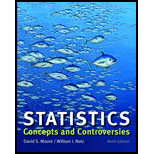
(a)
Section 1:
To find: The percentage of all attempted field goals made by Seth Fitzgerald.
(a)
Answer to Problem 20E
Solution: The required percentage is 53.33%.
Explanation of Solution
Calculation:
The percentage of field goals made by Seth Fitzgerald can be calculated as a ratio of the number of attempts, which are made by Seth Fitzgerald and total number of all attempted field goals by Seth Fitzgerald in a multiple of 100.
The total number of attempted field goal is calculated as:
The total number of field goals made by Seth Fitzgerald is calculated as:
Therefore, the required percentage is calculated as:
Section 2:
To find: The percentage of all attempted field goals made by Roberto Mantovani.
Solution: The required percentage is 53.84%.
Calculation:
The percentage of field goals made by Roberto Mantovani can be calculated as a ratio of the number of attempts that are made by Roberto Mantovani and total number of all attempted field goals in a multiple of 100.
The total number of attempted field goal is calculated as:
The total number of field goal made by Roberto Mantovani is calculated as:
Therefore, the required percentage is calculated as:
(b)
Section 1:
To find: The percentage of two-point and three-point field goals by Seth Fitzgerald.
(b)
Section 1:
Answer to Problem 20E
Solution: The percentages of two-point and three-point field goals are 55.56% and 50%.
Explanation of Solution
Calculation:
The percentage of two-point and three-point field goals can be calculated as a ratio of the number of attempts that are made by Seth Fitzgerald and the number of two-point and three-point field goals in a multiple of 100.
The total number of two-point attempted field goals by Seth Fitzgerald is calculated as:
The number of two-point field goals made is 5.
Therefore, the percentage of two-point field goals is calculated as:
The number of three-point attempted field goals is calculated as:
The number of three-point field goals made is 3.
Therefore, the percentage of three-point field goals made is calculated as:
Section 2:
To find: The percentage of two-point and three-point field goals by Roberto Mantovani.
Solution: The percentages of two-point and three-point field goals are 55.35% and 20%.
Explanation:
Calculation:
The percentage of two-point and three-point field goals made by Roberto Mantovani can be calculated as a ratio of the number of attempts that are made by Roberto Mantovani and the number of two-point and three-point field goals attempted in a multiple of 100.
The total number of two-point attempted field goals by Roberto Mantovani is calculated as:
The number of two-point field goals made is 62.
Therefore, the percentage of two-point field goals is calculated as:
The number of three-point field goals is calculated as:
The number of three-point field goals made is 1.
Therefore, the percentage of three-point field goals is calculated as:
(c)
To explain: The reason for which the provided statement is correct though its sounds to be impossible.
(c)
Answer to Problem 20E
Solution: As the number of goals made by Robert is more compared to the individual type of goals, the overall percentage is better.
Explanation of Solution
Want to see more full solutions like this?
Chapter 24 Solutions
Statistics: Concepts and Controversies
- A company found that the daily sales revenue of its flagship product follows a normal distribution with a mean of $4500 and a standard deviation of $450. The company defines a "high-sales day" that is, any day with sales exceeding $4800. please provide a step by step on how to get the answers in excel Q: What percentage of days can the company expect to have "high-sales days" or sales greater than $4800? Q: What is the sales revenue threshold for the bottom 10% of days? (please note that 10% refers to the probability/area under bell curve towards the lower tail of bell curve) Provide answers in the yellow cellsarrow_forwardFind the critical value for a left-tailed test using the F distribution with a 0.025, degrees of freedom in the numerator=12, and degrees of freedom in the denominator = 50. A portion of the table of critical values of the F-distribution is provided. Click the icon to view the partial table of critical values of the F-distribution. What is the critical value? (Round to two decimal places as needed.)arrow_forwardA retail store manager claims that the average daily sales of the store are $1,500. You aim to test whether the actual average daily sales differ significantly from this claimed value. You can provide your answer by inserting a text box and the answer must include: Null hypothesis, Alternative hypothesis, Show answer (output table/summary table), and Conclusion based on the P value. Showing the calculation is a must. If calculation is missing,so please provide a step by step on the answers Numerical answers in the yellow cellsarrow_forward
 MATLAB: An Introduction with ApplicationsStatisticsISBN:9781119256830Author:Amos GilatPublisher:John Wiley & Sons Inc
MATLAB: An Introduction with ApplicationsStatisticsISBN:9781119256830Author:Amos GilatPublisher:John Wiley & Sons Inc Probability and Statistics for Engineering and th...StatisticsISBN:9781305251809Author:Jay L. DevorePublisher:Cengage Learning
Probability and Statistics for Engineering and th...StatisticsISBN:9781305251809Author:Jay L. DevorePublisher:Cengage Learning Statistics for The Behavioral Sciences (MindTap C...StatisticsISBN:9781305504912Author:Frederick J Gravetter, Larry B. WallnauPublisher:Cengage Learning
Statistics for The Behavioral Sciences (MindTap C...StatisticsISBN:9781305504912Author:Frederick J Gravetter, Larry B. WallnauPublisher:Cengage Learning Elementary Statistics: Picturing the World (7th E...StatisticsISBN:9780134683416Author:Ron Larson, Betsy FarberPublisher:PEARSON
Elementary Statistics: Picturing the World (7th E...StatisticsISBN:9780134683416Author:Ron Larson, Betsy FarberPublisher:PEARSON The Basic Practice of StatisticsStatisticsISBN:9781319042578Author:David S. Moore, William I. Notz, Michael A. FlignerPublisher:W. H. Freeman
The Basic Practice of StatisticsStatisticsISBN:9781319042578Author:David S. Moore, William I. Notz, Michael A. FlignerPublisher:W. H. Freeman Introduction to the Practice of StatisticsStatisticsISBN:9781319013387Author:David S. Moore, George P. McCabe, Bruce A. CraigPublisher:W. H. Freeman
Introduction to the Practice of StatisticsStatisticsISBN:9781319013387Author:David S. Moore, George P. McCabe, Bruce A. CraigPublisher:W. H. Freeman





